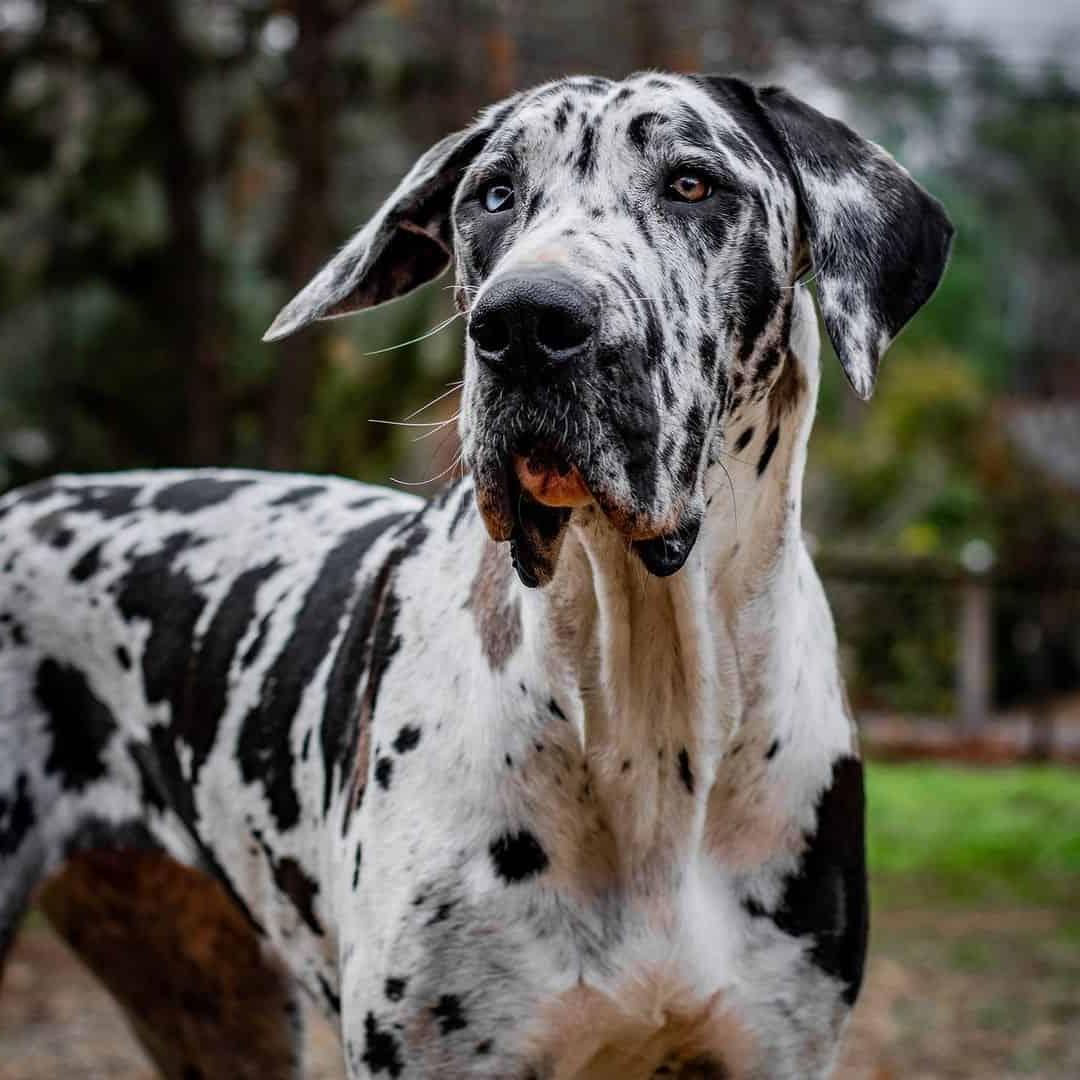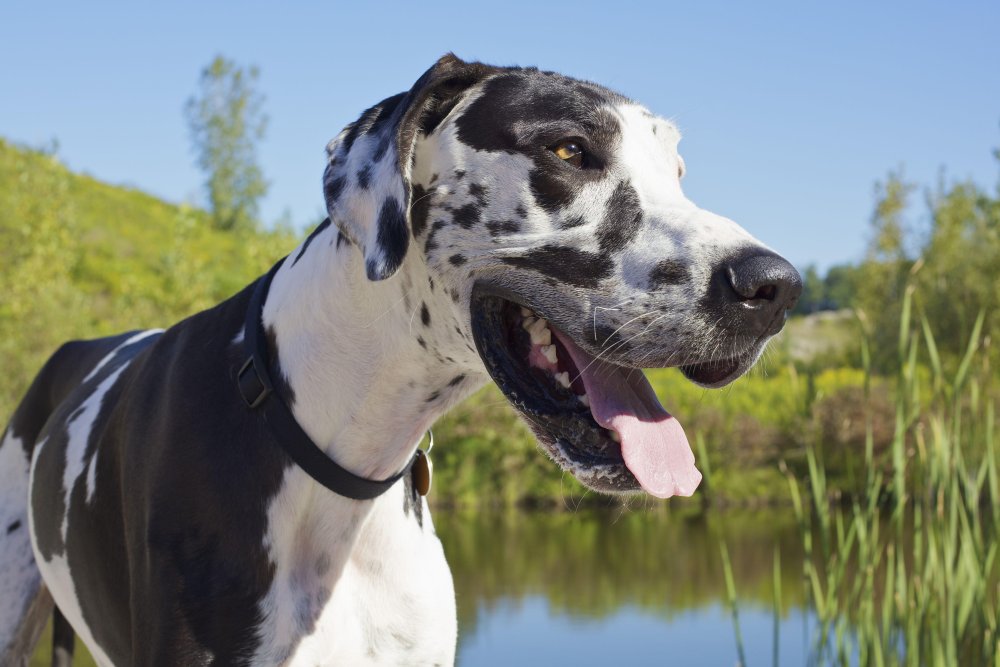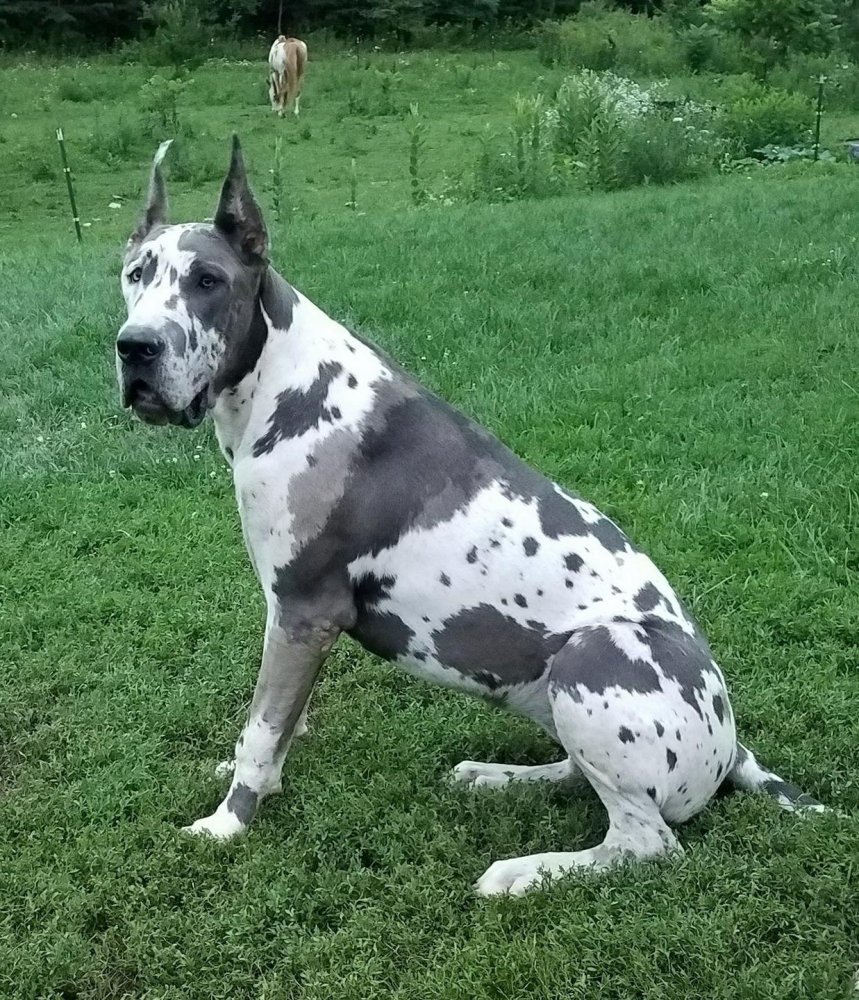- Breed Category: Working Group
- Country of Origin: Germany
- Average Height: Males 76-86 cm, Females 71-81 cm
- Average Weight: Males 54-90 kg, Females 45-59 kg
- Average Life Span: 7-10 years
- Grooming Requirements: Low, occasional brushing
- Exercise Requirements: Moderate, daily walks
- Coat Type: Short and smooth
- Coat Color Variations: Fawn, brindle, blue, black, harlequin
- Shedding Level: Moderate
- Ear Type: Naturally floppy
- Tail Type: Long and straight
- Temperament: Gentle, friendly, affectionate
- Intelligence Level: High
- Barking Tendency: Low
- Compatibility with Children: Excellent
- Compatibility with Other Pets: Good with proper socialisation
- Training Ease: Moderate, requires consistency
- Common Health Issues: Hip dysplasia, bloat, heart disease
- Dietary Needs: High-quality, large-breed diet
- Energy Level: Moderate
- Drooling Tendency: High
- Sensitivity to Weather: Sensitive to extreme temperatures
- Overall Maintenance Level: Moderate
- Original Purpose: Hunting and guarding
- Year of Recognition by Kennel Clubs: 1887
- Famous Breed Representatives: Scooby-Doo
- Apartment Friendly: Yes, with sufficient exercise
- Best Suited For: Families, active owners
- Cost of Ownership: High, due to size and health
- Unique Traits: Giant size, gentle nature
- Cultural Significance: Known as “Apollo of dogs”
- Popularity Rank: Top 20 in many countries
Did you know that the Great Dane can stand over 80 cm tall at the shoulder? This majestic breed, often referred to as the “Apollo of dogs,” is known for its impressive stature and gentle nature. Originating from Germany, Great Danes were initially bred for hunting wild boar, a task that required both strength and courage. Over time, they transitioned from hunters to beloved companions, admired for their loyalty and affectionate temperament. This article aims to delve into the unique characteristics, rich history, and essential care tips for Great Danes. Whether you’re considering bringing one into your home or simply curious about this remarkable breed, understanding their background and needs is key to appreciating their grandeur.
The Great Dane: A Majestic Breed with a Rich History

Early Development of the Breed
The Great Dane’s roots trace back to ancient times, with its ancestors believed to be a mix of English Mastiffs and Irish Wolfhounds. This blend of breeds was carefully crafted to create a dog that was both powerful and agile, capable of taking on formidable prey. The breed’s development was a meticulous process, aimed at achieving the perfect balance of strength and grace.
Role in European Hunting and Guarding
In Europe, particularly in Germany, Great Danes were prized for their hunting prowess. They were the go-to choice for hunting wild boar, a dangerous game that required a dog with both courage and tenacity. Beyond hunting, these dogs were also used as guardians, protecting estates and families with their imposing presence and loyal nature.
Key Historical Figures and Regions
German nobility played a significant role in the Great Dane’s development. Figures like Count von Platen-Hallermund were instrumental in refining the breed, ensuring it met the high standards of the time. The regions of Germany, particularly the duchies, were central to the breed’s evolution, with breeders focusing on enhancing their size and temperament.
Physical Characteristics
Great Danes are known for their towering height and muscular build. Their sleek, short coat comes in a variety of colours, including fawn, brindle, and harlequin. Despite their size, they move with an elegance that belies their strength, making them a true spectacle to behold.
Appearance and Unique Physical Traits
Great Danes are truly a sight to behold. Standing tall and proud, they can reach over 80 cm at the shoulder, making them one of the tallest dog breeds around. Their coat is short and sleek, coming in a range of colours like fawn, brindle, and the striking harlequin pattern. Each colour adds its own touch of elegance to their already impressive appearance.
What sets them apart is not just their size but their graceful build. Despite their massive frame, they move with a surprising elegance, almost like they’re gliding. This combination of height and grace is why they’re often called the “Apollo of dogs.”
Temperament and Behaviour
Don’t let their size fool you; Great Danes are gentle giants. Known for their friendly and affectionate nature, they make excellent companions. They’re generally good with kids and other pets, thanks to their patient and calm demeanour. However, their size means they need space to move around, and they thrive in environments where they can stretch their legs.
Great Dane: The Ideal Family Companion

Typical Personality Traits
Great Danes are often described as gentle giants. Their calm and friendly nature makes them perfect companions for families. They’re known for their loyalty, always eager to please their human companions. Despite their imposing size, they are incredibly sociable and enjoy being part of family activities.
Suitability as a Family Pet and Watchdog
These dogs are well-suited to family life. Their gentle disposition means they get along well with children, and their loyalty makes them excellent watchdogs. While they may not be aggressive, their sheer size and deep bark can deter potential intruders.
Interaction with Children and Other Animals
Great Danes are generally good with kids, often displaying patience and a protective instinct. They also tend to get along with other animals, especially if socialised from a young age. Their friendly nature makes them a great addition to multi-pet households.
Training and Exercise Needs
Training a Great Dane is usually straightforward due to their eagerness to please. Consistent, positive reinforcement works best. They require regular exercise to maintain their health, but they don’t need as much as some other large breeds. A daily walk and some playtime in a secure area are usually sufficient.
Training and Care for Your Great Dane

Importance of Early Training and Socialisation
Getting your Great Dane started with training and socialisation early on is crucial. These gentle giants grow quickly, and it’s important they learn good manners before they become too big to handle. Early socialisation helps them become well-adjusted adults, comfortable around different people, pets, and environments.
Recommended Training Techniques
Great Danes respond well to positive reinforcement. Use treats, praise, and play to reward good behaviour. Consistency is key, so make sure everyone in the household is on the same page with commands and rules. Short, fun training sessions work best to keep their attention.
Daily Exercise Requirements and Activities They Enjoy
While they might not need as much exercise as some other large breeds, Great Danes still require daily activity to stay healthy. A couple of walks a day and some playtime in a secure area usually do the trick. They enjoy activities like fetch or even a gentle jog alongside you.
Health and Lifespan
Great Danes have a relatively short lifespan, typically around 7 to 10 years. Regular vet check-ups and a balanced diet are essential to keep them healthy. Be aware of common health issues like hip dysplasia and bloat, and consult your vet for advice on prevention and care.
Health and Care for Your Great Dane

Common Health Issues
Great Danes, like many large breeds, are prone to certain health issues. Hip dysplasia and bloat are common concerns. Bloat, in particular, is a serious condition that requires immediate attention. Regular vet visits can help catch these issues early.
Average Lifespan and Health Tips
With a lifespan of about 7 to 10 years, Great Danes need attentive care to maximise their years. A balanced diet, regular exercise, and routine vet check-ups are key. Keeping their weight in check can also help prevent joint problems.
Preventative Care Recommendations
Preventative care is crucial. Regular vaccinations, flea and tick prevention, and dental care should be part of their routine. Discuss with your vet about supplements that might benefit their joints and overall health.
Grooming and Maintenance
Despite their size, Great Danes are relatively low-maintenance when it comes to grooming. Their short coat requires weekly brushing to keep it looking sleek. Regular nail trimming and ear cleaning are also important to prevent infections.
Coat Care and Grooming for Your Great Dane
Coat Care and Grooming Routines
Great Danes have a short, sleek coat that’s surprisingly easy to maintain. A weekly brush with a soft-bristle brush or grooming mitt will keep their coat looking its best and help reduce shedding. Regular grooming sessions also provide a great opportunity to check for any skin issues or parasites.
Shedding and Seasonal Grooming Tips
While Great Danes don’t shed excessively, they do experience seasonal shedding, usually in spring and autumn. During these times, you might need to brush them more frequently to manage the extra hair. A good bath every few months or when they get particularly dirty will also help keep their coat clean and healthy.
Diet and Nutrition
Feeding your Great Dane a balanced diet is crucial for their health and longevity. Look for high-quality dog food that meets their nutritional needs, focusing on protein and healthy fats. Due to their size, they can be prone to bloat, so it’s best to feed them smaller meals multiple times a day rather than one large meal. Always consult your vet for specific dietary recommendations tailored to your dog’s needs.
Nutritional Needs and Feeding Tips for Your Great Dane
Optimal Nutrition for Health
Great Danes need a diet rich in protein and healthy fats to support their large frames and active lifestyles. Look for high-quality dog food that lists meat as the first ingredient. Omega-3 and Omega-6 fatty acids are also beneficial for their skin and coat health.
Foods to Include and Avoid
Include lean meats, fish, and whole grains in their diet. Avoid foods high in fillers, artificial preservatives, and excessive fat. Grapes, chocolate, and onions are toxic to dogs and should be kept out of reach.
Feeding Schedules and Portion Recommendations
To prevent bloat, a common issue in Great Danes, feed them smaller meals two to three times a day instead of one large meal. Consult your vet for portion sizes, as these can vary based on age, weight, and activity level.
Fun Facts and Trivia
Did you know that Great Danes were once used to hunt wild boar? Despite their hunting past, they are now known for their gentle and affectionate nature. Their impressive size and friendly demeanour make them a favourite in many households.
Famous Great Danes in Media and History

Great Danes in Popular Culture
Great Danes have made quite a splash in the world of media. One of the most iconic is Scooby-Doo, the lovable, mystery-solving dog from the animated series. His goofy antics and insatiable appetite have entertained audiences for decades. Another famous Great Dane is Marmaduke, the comic strip character known for his larger-than-life personality and humorous escapades.
Historical Great Danes
Beyond the screen, Great Danes have also left their mark in history. In the 18th century, a Great Dane named Juliana was awarded a Blue Cross Medal for extinguishing an incendiary bomb during World War II. Her bravery and quick thinking saved lives, showcasing the breed’s intelligence and courage.
Interesting Tidbits
- Great Danes were once considered a symbol of status and wealth among European nobility.
- Despite their size, they are known for their gentle and friendly nature, earning them the nickname “gentle giants.”
- Their impressive stature often makes them a favourite in dog shows, where they are admired for their elegance and poise.
Final Thoughts

The Great Dane is a majestic and gentle giant. Known for their impressive stature and affectionate nature, they make excellent family companions. Despite their size, they are surprisingly graceful and require moderate exercise and care. Understanding their unique needs and history enhances the joy of owning such a remarkable breed. Consider welcoming a Great Dane into your home for a loyal and loving addition to your family.
